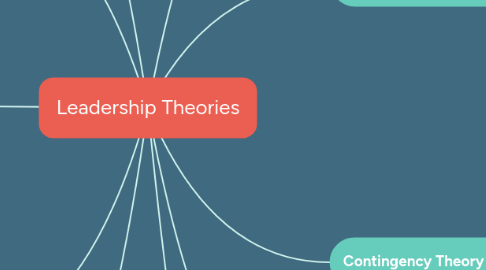Leadership Theories
by Sir Snowden


1. Trait Theory
1.1. People in managerial positions have designated leadership profiles (Northouse, 2018, p.78)
1.2. Is that it is not a useful approach for training and development for leadership (Northouse, 2018, p. 81
1.3. Major Leadership Traits; Self-Confidence, determination, intelligence, sociability, and integrity (Northouse, 2018, p.67)
2. Transformational Theory
2.1. Engages with others and create a connection that raises the level of motivation and morality in both the leader and follower (Northouse, 2018, p. 264)
2.2. Provides leaders with information about a full range of their behaviors, from nontransactional to transactional to transformational (Northouse, 2018, p. 288)
2.3. Create change that will help grow and shape the future success of the company (White, 2018)
3. Behavioral Theory
3.1. The scope of leadership research to include the behaviors of leaders and what they do in various situations (Northouse, 2018, p. 146)
3.2. Leaders can assess their actions and determine how they may want to change to improve their leadership behaviors (Northouse, 2018, p. 146)
3.3. Applies to nearly everything a leader does (Northouse, 2018, p. 149)
4. Situational Theory
4.1. Is constructed around the idea that followers move forward and backward along the developmental continuum, which represents the relative competence and commitment of followers (Northouse, 2018, p. 172)
4.2. To leadership has several strengths, particularly for practitioners (Northouse, 2018, p.174)
4.3. The situational leadership model enables a leader to identify a task, set goals, determine the task maturity of the individual or group, select an appropriate leadership style, and modify the style as change occurs (Waller, Smith, & Warnock, 1989).
5. Adaptive Leadership Theory
5.1. Is about helping others to explore and change their values (Northouse, 2018, p. 393)
5.2. Is a unique kind of leadership that focuses on the dynamics of mobilizing people top address change (Northouse, 2018, p.395)
5.3. Includes rewards Corazzini, K. N., & Anderson, R. A., 2014, p.353)
6. Great-Man Theory
6.1. Proponents of the Great Man Theory also believe that regardless of the innate talents potential leaders might possess, without the timely emergence of situational forces they will not become leaders (Cawthon, 1996, p. 3).
6.2. The leaders are born and not made and posses certain traits which were inherited (Juneja).
6.3. Great leaders can arise when there is a great need (Juneja).
7. Transactional Theory
7.1. Contingent reward, the process of setting expectations and rewarding workers for meeting them (St. Thomas University, 2018)
7.2. Provides an unambiguous structure for large organizations, systems requiring repetitive tasks and infinitely reproducible environments (St. Thomas University, 2018)
7.3. Is a "telling" leadership style (St. Thomas University, 2018)
8. Contingency Theory
8.1. This theory puts forth the idea that effective leadership hinges not only on the style used by the leader, but also on the control held over the situation (Villanova, 2019)
8.2. The contingency theory emphasizes the importance of both the leader's personality and the situation in which that leader operates (Virkus, 2009))
8.3. That the success of a leader depends upon their style of leadership and on the kind of control that exists in a situation (LaMarco, 2018).
9. Path-Goal Theory
9.1. �������� � ��� �� ������� ��������������� ����� �� ��� ��������������� �� ��������� ��� ����� ��� ��� ������� ������ ��� �� ������� ������ ���� ���� �� �� �����
9.1.1. Provides a set of general recommendations based on the characteristics of follower and tasks for how leaders should act in various situations if they want to be effective (Northouse, 2018, p. 212)
